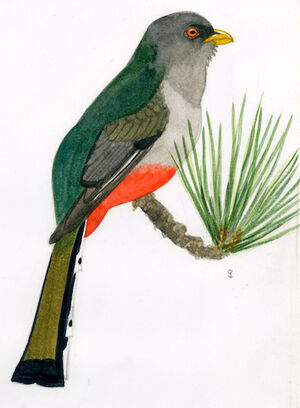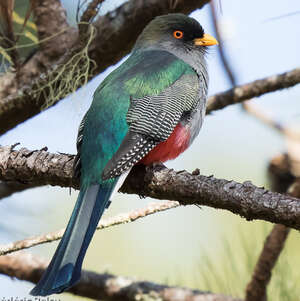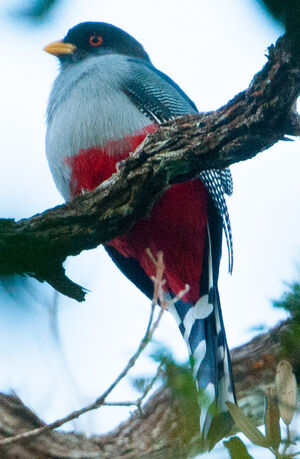Hispaniolan Trogon
Priotelus roseigaster - Trogon damoiseau
Identification
Priotelus roseigaster, or the remarkable arrow with the red belly, is etymologically speaking (and with all due caution!) for the knowledgeable latinists. Taxonomy being a controversial and changing science, it is also known as Temnotrogon roseigaster; let's stick to the French name, which is more poetic: Hispaniolan Trogon. It is a 30 cm trogon of which the dimorphism is less severe than other American species. The males have a strong and slightly curved yellow beak surrounded by black vibrissae, a black forehead encircling an orange iris. The crown and nape are tinted a pale green with a bronze glitter depending on the light. The mantle and scapulars are emerald green with blue reflections, the coverts and tertiary remiges are visibly striped horizontally in black and white, the primary and secondary remiges have distinct black and white spots distinct from the covering markings, the shoulder is black and contrasts with the black and white alternate pattern of the coverts and remiges. At the end of the green tail-base is the upper middle rectrix, bronze green, framed by the darker blue inner rectrices and the ends in blue. The dark grey throat fades onto the chest, and the underside and belly are a vivid red, sometimes showing a very slight white line separating the chest and belly in some individuals, yet not systematically. The lower rectrices are marked with three black and white stripes, starting with black at the base of the belly; the white areas are wide and have a unique blackpoint at their end, specific to the species. The female, comparatively to other trogon species, is less distinct; the crown is rather light grey, the coverts have no stripes and are grey-green, sometimes grey in certain individuals, the tertiary remiges have an ochre-green hue and the primary remiges are a dark grey with clearly outlined white borders.The tarsi, which are usually not very visible in most trogons, are brown-gray. Juveniles resemble their mothers.
Subspecific information monotypic species
Foreign names
- Trogon damoiseau,
- Trogón de La Española,
- surucuá-haitiano,
- Hispaniolatrogon,
- rózsáshasú trogon,
- Hispaniolatrogon,
- Trogone di Hispaniola,
- hispaniolatrogon,
- Hispaniolatrogon,
- tokororo žltozobý,
- trogon hispaniolský,
- Hispaniolatrogon,
- hispaniolantrogoni,
- trogon de la Hispaniola,
- pilik żółtodzioby,
- Розовобрюхий трогон,
- ヒスパニオラキヌバネドリ,
- 伊岛咬鹃,
- hispaniolatrogon,
- 希斯潘諾拉咬鵑,
Voice song and call
Habitat
The Hispaniolan Trogon prefers mountain forests, especially pine forests, but it can also be found in deciduous forests or near mangroves.
Behaviour character trait
As a resident exclusive to the island, the Hispaniolan Trogon descends to lower altitude forest or near the mangroves when the breeding season is over, that is, from August to February.
Dietfeeding habits
Our Hispaniolan Trogon is more insectivorous than many of its cousins, insects are captured both on the ground and in flight, it varies its diet with lizards and various fruits.
Reproduction nesting
There are very few observations on the reproduction of the Hispaniolan Trogon. The breeding season takes place between March and July. American ornithologist Alexander Wetmore saw in 1931, in the south of Haiti, six Hispaniolan Trogons in a ceremony he assumed to be nuptial. The perched birds stretched their necks and showed their vertical tails and then lowered them to a right angle, to quickly raise them back to their initial position. Following this demonstration, the males loudly beat their wings and emitted high-pitched cries. Similar observations have been made with Apaloderma trogans in Africa. The nests are dug out in old trees, about 5 meters high, the Hispaniolan Trogon often using nests from Hispanaiolan's woodpeckers, Melanerpes striatus. The clutch is two eggs, unfortunately there is little information about the incubation period and the raising of the chicks.
Geographic range
Hispaniolan Trogon's Anglo-Saxon name is quite telling: Spanish for Hispaniola, the island that was historically shared between Haiti and the Dominican Republic. The Hispaniolan Trogon is strictly sedentary here. It can most easily be spotted in Central Dominican mountain ranges such as Sierra de Neiba and Baoruco, as well as in the Northern range. In Haiti, its sightings are far and few, but it can still be found in the Hotte massif.
Threats - protection
IUCN conservation status
concern
in the Wild
threatened
evaluated
Near Threatened: Almost threatened. The situation of the Hispaniolan Trogon is probably very critical in Haiti where deforestation is very significant, the wood being used to make charcoal for cooking and heating. It is known to be occasionally hunted... for its meat, but what can be blamed on a population that is deprived of everything? The situation is a bit less critical in the Dominican Republic but the balance remains fragile. The task is immense to save this beauty.
Sources of information
- IOC World Bird List (v15.1), Gill, F and D Donsker (Eds). 2025-12-07.
- A Natural history of the Trogonidae, Joseph M.Forshaw Albert Earl Gilbert
- Vol. 6 - Handbook of the Birds of the World, Josep del Hoyo-Andrew Elliott-Jordi Sargatal
- xeno-canto, Sharing bird sounds from around the world,
- Avibase, Lepage Denis
- BirdLife International, BirdLife International
- Neotropical Birds Online,
- Wikipédia, Wikipedia, The Free Encyclopedia
Other sources of interest
 Specification sheet created on
30/07/2023 by Anne et Gabriel Leboff
Specification sheet created on
30/07/2023 by Anne et Gabriel LeboffTranslation by AI Oiseaux.net
© 1996-2025 Oiseaux.net
- Accipitriformes
- Aegotheliformes
- Anseriformes
- Apodiformes
- Apterygiformes
- Bucerotiformes
- Caprimulgiformes
- Cariamiformes
- Casuariiformes
- Charadriiformes
- Ciconiiformes
- Coliiformes
- Columbiformes
- Coraciiformes
- Cuculiformes
- Eurypygiformes
- Falconiformes
- Galliformes
- Gaviiformes
- Gruiformes
- Leptosomiformes
- Mesitornithiformes
- Musophagiformes
- Nyctibiiformes
- Opisthocomiformes
- Otidiformes
- Passeriformes
- Pelecaniformes
- Phaethontiformes
- Phoenicopteriformes
- Piciformes
- Podargiformes
- Podicipediformes
- Procellariiformes
- Psittaciformes
- Pterocliformes
- Rheiformes
- Sphenisciformes
- Steatornithiformes
- Strigiformes
- Struthioniformes
- Suliformes
- Tinamiformes
- Trogoniformes






